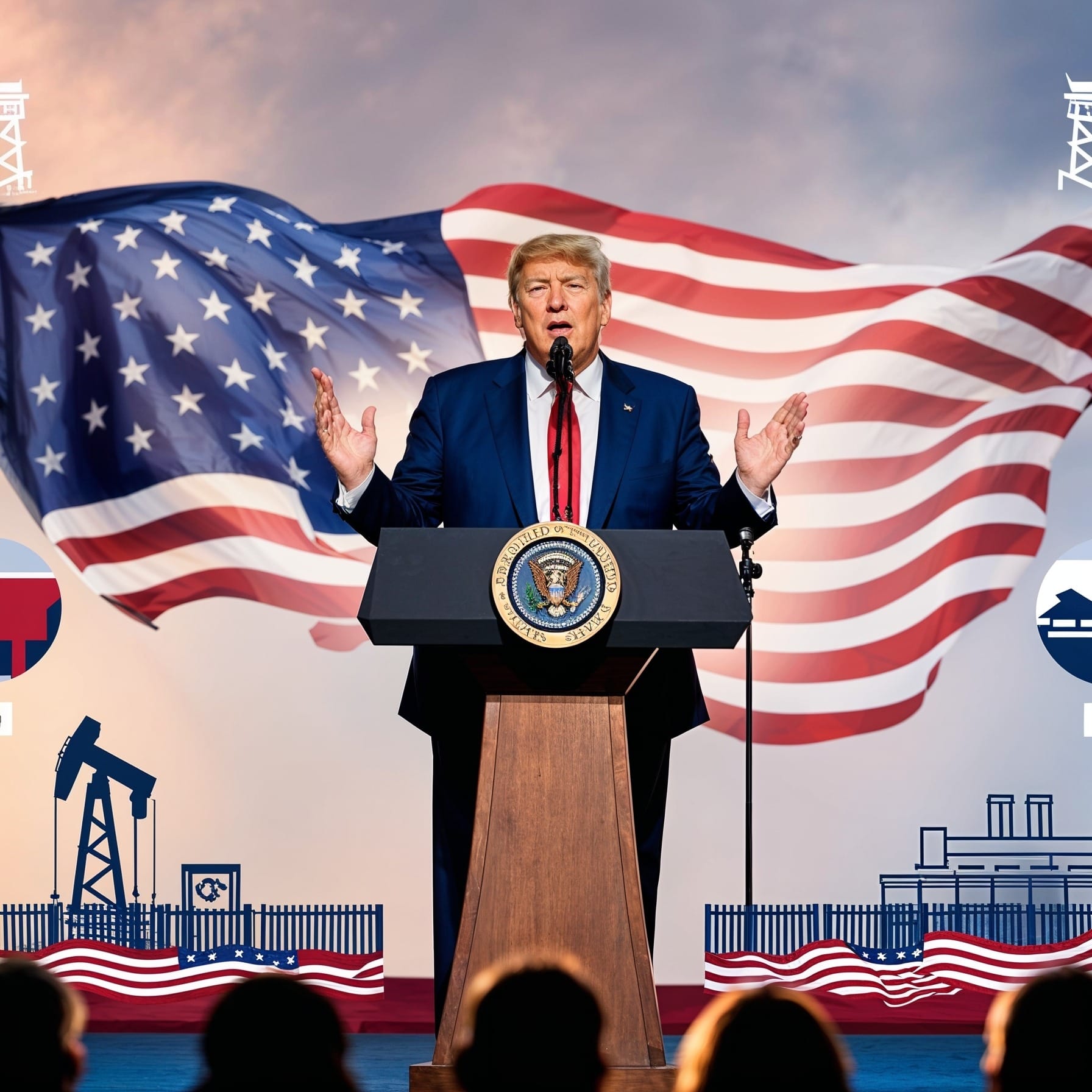
Donald Trump outlining his “America First” priorities for his second term, focusing on energy, immigration, and national security.
As Donald Trump prepares for his potential return to the presidency, his transition plans are already making headlines. Focused on reversing key policies from the Biden administration, reshaping federal operations, and pushing forward his “America First” agenda, Trump’s approach highlights his intent to deliver immediate, sweeping changes. From assembling a loyal team to issuing decisive executive orders on immigration, energy, healthcare, and education, these plans are as ambitious as they are transformative.
The Donald Trump Transition Plans aim to streamline government efficiency through innovation, restore national security by enforcing strict immigration policies, and revitalize the economy with a renewed focus on domestic energy and manufacturing. With a mix of bold reforms and strategic appointments, Trump’s second-term blueprint signals a relentless commitment to reshaping America’s future.
In this article, we’ll break down Trump’s key initiatives, his first-day priorities, and the long-term vision driving his transition strategy. Whether you support or critique these plans, their impact on the nation’s trajectory cannot be ignored.
Assembling a Cohesive Transition Team
A well-organized and loyal team is the foundation of any successful administration. Trump’s 2024 transition strategy focuses on assembling advisors who align with his Donald Trump Transition Plans, ensuring that policies are implemented without delays. Drawing on lessons from the 2016 transition, his approach emphasizes avoiding bureaucratic bottlenecks, particularly in critical agencies like Homeland Security and Justice.
Executive Orders: Day-One Reversals
Trump is likely to begin his second term by issuing executive orders aimed at reversing Biden-era regulations across multiple sectors:
- Energy: Rollback of emissions standards and reinstatement of policies favorable to fossil fuel production.
- Immigration: Restoring the “Remain in Mexico” policy and resuming border wall construction.
- Healthcare: Undoing ACA expansions and enabling states to pursue alternative models.
- Education: Countering perceived “liberal indoctrination” in public schools through curriculum reforms.
These actions signal Trump’s readiness to fulfill campaign promises immediately, bypassing legislative gridlock.
Key Appointments and Strategic Leadership
Trump’s early appointments underscore a vision for efficiency and policy reform:
- Scott Bessent (Treasury Secretary): Combines fiscal expertise with a commitment to deficit reduction.
- Russell Vought (OMB): A trusted conservative voice to restore disciplined federal spending.
- Rep. Lori Chavez-DeRemer (Labor Secretary): Aligns with labor union collaboration and PRO Act reforms.
Department of Government Efficiency: Streamlining Governance
The creation of the Department of Government Efficiency is central to Trump’s transition plans. Co-led by Elon Musk and Vivek Ramaswamy, this initiative aims to reduce federal waste, saving $2 trillion by mid-2026. Trump’s reliance on public-private partnerships and innovative leadership highlights his commitment to modernizing government operations.
Immigration Policies: Broadening the Scope
Immigration reforms remain at the forefront of Trump’s priorities:
- Border Enforcement: Expanding deportations, reinstating the “Remain in Mexico” policy, and resuming wall construction.
- Legal Immigration Limits: Tightening work and student visa requirements while prioritizing skilled worker programs to boost economic competitiveness.
- Asylum Reforms: Implementing stricter vetting processes to curb abuse of asylum laws.
These measures aim to restore control at the southern border and realign immigration policies with national security and economic goals.
Healthcare Overhaul: Affordable and Accessible Solutions
The appointment of Dr. Mehmet Oz to lead Medicare and Medicaid Services underscores Trump’s focus on healthcare reform. Key initiatives include:
- Lowering Drug Costs: Revisiting proposals to import affordable medications from countries like Canada.
- Revising ACA Reforms: Supporting state-level healthcare innovations to reduce federal overreach.
- Market-Driven Solutions: Encouraging competition among providers to deliver affordable care for middle-class families.
These policies aim to make healthcare more accessible while preserving individual choice.
Surveillance Reforms: Privacy and Accountability
Trump’s second term will likely prioritize reforming intelligence agencies to increase accountability and restore public trust. Specific measures include:
- Oversight Mechanisms: Establishing independent panels to review practices within the FBI, CIA, and NSA.
- Privacy Protections: Limiting domestic surveillance programs by enhancing judicial oversight and requiring stricter criteria for wiretaps.
- Transparency Initiatives: Increasing public awareness of agency activities to reduce perceived overreach.
These efforts reflect Trump’s commitment to balancing national security with individual liberties.
Energy Independence: Revitalizing Domestic Production
Trump’s energy policies focus on reducing reliance on foreign oil while revitalizing U.S. production:
- Drilling and Permits: Opening more federal lands for energy exploration and streamlining permit processes.
- Keystone XL Pipeline: Reviving this project as a symbol of energy independence.
- Regulatory Rollbacks: Eliminating emissions restrictions to support coal, natural gas, and oil industries.
By prioritizing domestic energy, Trump aims to create jobs and bolster America’s global leadership in fossil fuel production.
Manufacturing and Infrastructure: Rebuilding American Industry
Trump’s economic vision emphasizes self-sufficiency and industrial strength:
- “Made in America”: Tax incentives for manufacturers relocating production to U.S. soil, coupled with penalties for outsourcing.
- Public-Private Partnerships: Collaborations to modernize factories in hard-hit regions, particularly the Rust Belt.
- Infrastructure Investments: Large-scale projects targeting roads, bridges, electrical grids, and energy pipelines to sustain long-term economic growth.
These measures aim to restore America’s economic vitality while reinforcing its competitive edge.
Education and Cultural Policies
Trump’s cultural policies focus on reshaping educational narratives and expanding parental choice:
- Patriotic Curriculum Reforms: Federal incentives for states to adopt curriculums emphasizing traditional American values and civic responsibility.
- Critical Race Theory Opposition: Targeting divisive ideologies in schools to promote national unity.
- School Choice Expansion: Increasing funding for charter schools, private vouchers, and homeschooling programs.
These reforms aim to decentralize education while empowering parents to make decisions aligned with their values.
Election Integrity: Restoring Confidence
Election security is a cornerstone of Trump’s transition plans, with reforms designed to address vulnerabilities:
- Voter ID Requirements: Advocating for nationwide voter identification laws to enhance election integrity.
- Mail-In Voting Reforms: Introducing stricter verification processes, including signature matching and submission deadlines.
- Ballot Tracking Systems: Implementing end-to-end tracking for transparency and public trust.
These measures aim to reassure voters and prevent future controversies over election outcomes.
DARWIN’s Take: Strategic or Overreaching?
Trump’s transition plans reflect a meticulous strategy to consolidate power, reform critical systems, and prioritize “America First.” While these bold moves resonate with his base, they raise questions about potential overreach. Whether Trump’s vision thrives or faces resistance, it promises to reshape America’s political and economic landscape.
Sources
- Pew Research Center: Provides insights into public opinion regarding President-elect Trump’s policies and transition conduct.
- PolitiFact: Offers analysis of Trump’s second-term plans on key issues such as the economy, immigration, and healthcare.
- Reuters: Reports on Trump’s consideration of Richard Grenell for a special envoy role in the Russia-Ukraine conflict.
- The New York Post: Details Trump’s appointment of Scott Bessent as Treasury Secretary, highlighting his economic strategy.
- The Times: Discusses the “DOGE Plan” aimed at government reform, emphasizing efficiency and cost-saving measures.
- Vanity Fair: Covers a series of rapid appointments by Trump, including key positions in his upcoming administration.
- Associated Press: Analyzes how Trump’s health agency picks could influence significant policy changes.
- Business Insider: Profiles new staffers poised to shape U.S. policies starting in 2025 under Trump’s leadership.
Related Paranoid ProphetArticles
- Trump Tariffs for Mexico and Canada
Explore the economic and political impacts of Trump’s proposed 25% tariffs on Mexico and Canada. Learn how these tariffs could reshape trade dynamics, pricing, and North American manufacturing. - Marco Rubio: Why He’s a Poor Fit for Secretary of State
Explore why Marco Rubio’s neoconservative and hawkish stance could make him unsuitable as Secretary of State, analyzing its potential impact on U.S. foreign policy and global diplomacy.
Hegseth VA Reform: Can Veterans Finally Get the Care They Deserve? - Assess Pete Hegseth’s proposed VA reforms and their potential to improve healthcare services for veterans, addressing longstanding systemic issues.
Pete Hegseth as Secretary of Defense: Future Impact to the Pentagon - Analyze the implications of appointing Pete Hegseth as Secretary of Defense, focusing on prospective changes within the Pentagon and defense policies.
- Matt Gaetz Human Trafficking Allegations: Media Smear Campaign or Manufactured Scandal?
Investigate the human trafficking allegations against Matt Gaetz, exploring whether they constitute a media smear campaign or a manufactured scandal. - RFK Jr.: A Game-Changing Nominee for Secretary of Health and Human Services
Examine the potential impact of RFK Jr.’s nomination as Secretary of Health and Human Services, considering his views on public health and policy reform. - Why America Needs a Department of Government Efficiency—and Why Elon Musk Should Lead It
Discuss the necessity of a Department of Government Efficiency in the U.S. and propose Elon Musk as a visionary leader to spearhead governmental innovation.
Frequently Asked Questions
1. What are Donald Trump’s plans for his second term as president?
Donald Trump’s transition plans for his second term include a focus on restoring election integrity, bolstering U.S. manufacturing, strengthening law enforcement, and prioritizing energy independence. He is also expected to pursue reforms in education, immigration enforcement, and foreign policy, aligning with his “America First” philosophy.
2. How does Donald Trump plan to address election security during his transition?
Trump’s election security plans involve pushing for nationwide voter ID laws and stricter mail-in voting regulations. His proposals aim to standardize voting practices, require signature verification for mail-in ballots, and enforce deadlines to ensure accurate and timely election results.
3. Will Donald Trump bring back the “Remain in Mexico” policy?
Yes, Trump’s immigration transition plans include reinstating the “Remain in Mexico” policy, which requires asylum seekers to stay in Mexico while their U.S. claims are processed. This policy is part of his broader focus on border security and reducing illegal immigration.
4. What is Donald Trump’s stance on NATO during his second term?
Trump’s transition plans for NATO involve recalibrating the U.S. role in the alliance by pushing for fairer financial contributions from member nations. He aims to focus NATO’s priorities on areas critical to U.S. interests, such as countering Chinese influence in the Indo-Pacific.
5. How will Donald Trump’s energy policies affect the U.S. economy?
Trump plans to prioritize energy independence by expanding domestic drilling, rolling back emissions regulations, and reopening projects like the Keystone XL pipeline. These initiatives are designed to create jobs, reduce reliance on foreign oil, and strengthen America’s position as a global energy leader.
6. What education reforms are part of Donald Trump’s second-term agenda?
Trump’s education reforms focus on implementing a “patriotic education” curriculum that emphasizes traditional American values and civic responsibility. He also plans to expand school choice programs, including charter schools and vouchers, to give parents more control over their children’s education.
7. How will Donald Trump support law enforcement during his second term?
Trump’s transition plans for law enforcement include increasing federal funding for local police departments, strengthening community policing programs, and creating federal task forces to combat drug trafficking and organized crime.
8. What infrastructure projects does Donald Trump plan to prioritize?
Trump plans to champion large-scale infrastructure projects such as modernizing highways, upgrading the electrical grid, and reviving the Keystone XL pipeline. These projects aim to boost job creation, enhance energy independence, and maintain America’s global competitiveness.
9. What changes does Donald Trump propose for U.S. manufacturing?
Trump’s manufacturing agenda includes tax breaks and regulatory cuts to encourage companies to relocate production to the U.S. He also plans to impose tariffs on foreign-made goods in critical industries like electronics and pharmaceuticals, aiming to revive domestic production and create jobs.
10. How will Donald Trump’s foreign policy differ during his second term?
Trump’s foreign policy will focus on limiting U.S. military involvement abroad while emphasizing diplomacy and national sovereignty. He plans to broker peace talks in the Ukraine-Russia conflict, reassess NATO’s financial contributions, and counter China’s growing influence.


